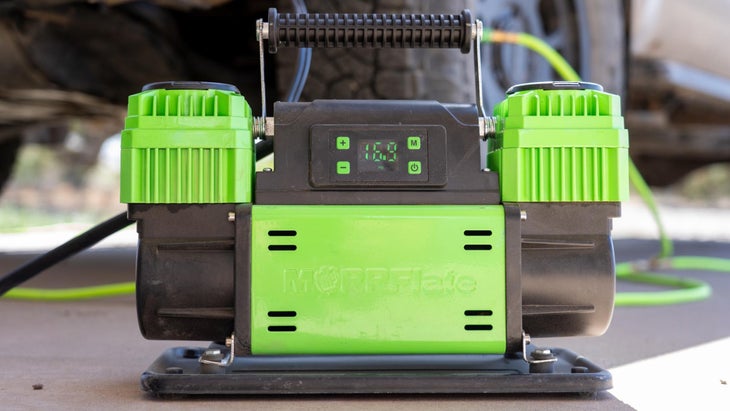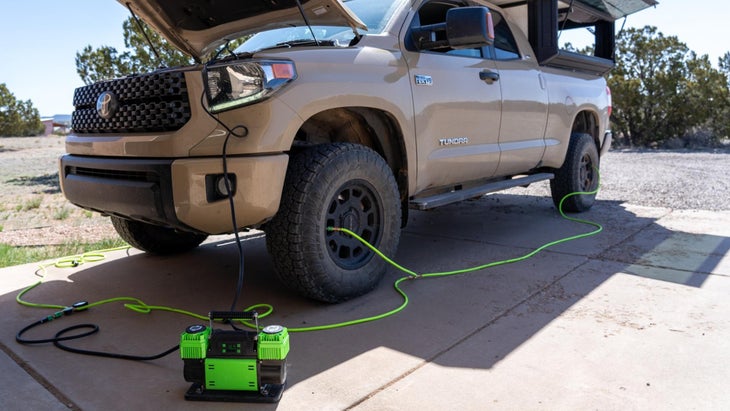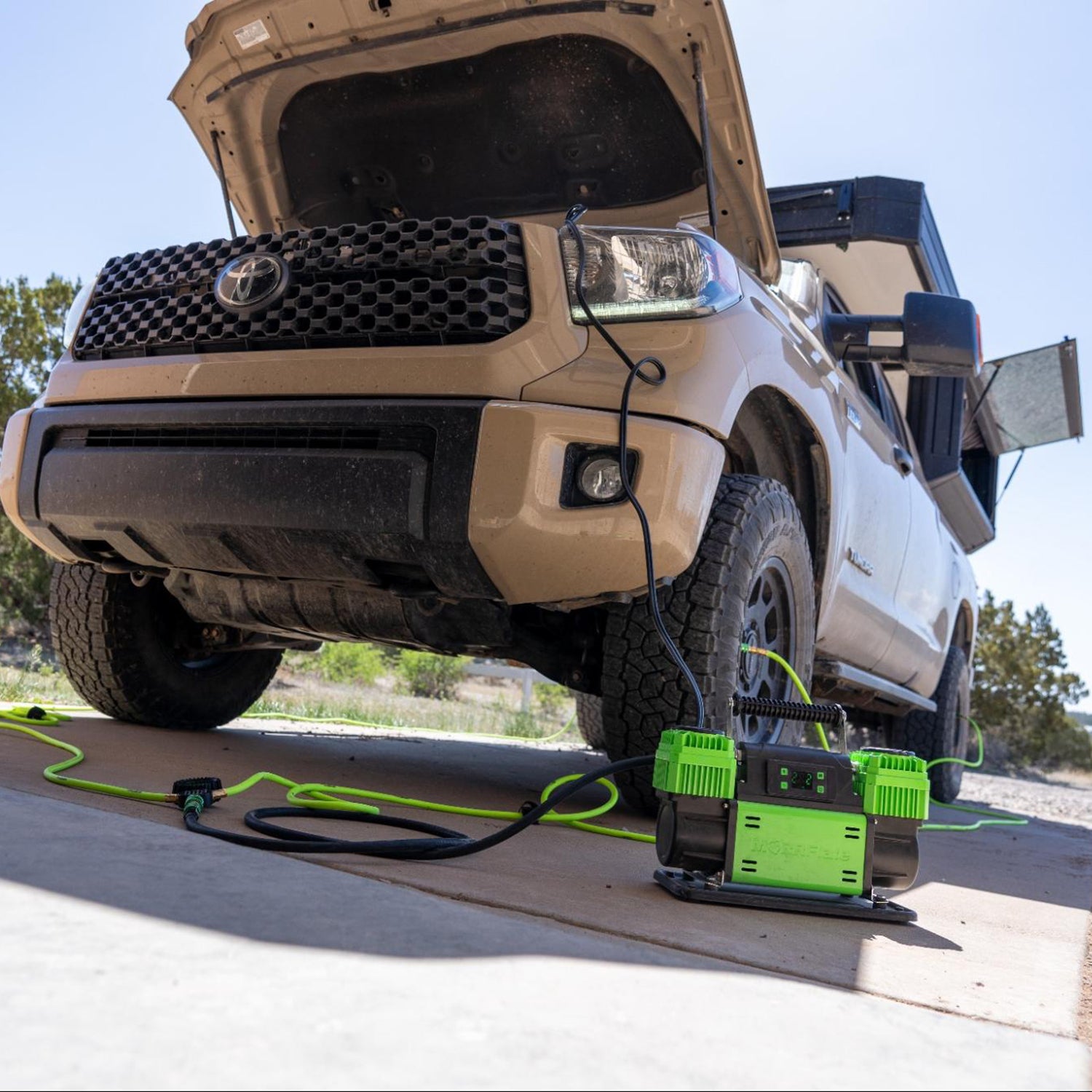Most people who spend time driving their rig off pavement know the benefits of letting air out of their tires (also known as “airing down”), but I’m willing to bet that they don’t do it as often as they should.
I’m guilty of this even though I’ve written about overlanding and off-road gear for nearly a decade. Why do we skip this important step venturing off pavement? Because airing down is a pain. When you air down, you need to fill those tires back up once you return to pavement, and that takes time.
For years, my go-to air compressor was the VIAR 400-P (I ran both the portable version and the brand’s continuous on-board system in several rigs). It was the best value air compressor I could find, and did a pretty decent job of re-inflating my truck and trailer tires. But it usually took around 15 to 20 minutes.
In an attempt to find a quicker solution, I came across the and have been testing it over the last several months. It had great reviews, and I had high expectations going into testing. Did it live up to the hype? Short answer: Yes.
Why Do You Need an Air Compressor in Your Rig?
Let’s review why you should let the air out of your tires whenever you drive your truck, van, or other adventure rig off road. Doing so has numerous benefits, like increasing traction and flotation in soft, slippery surfaces, reducing wear on your vehicle’s drivetrain, and making your ride a lot more comfortable on dirt roads. That’s especially true if you run heavy all-terrain or mud-terrain tires on your rig, since those are meant to be aired down off road.
Think of it like setting the pressure on your mountain bike’s tires: you might run 40 psi if you’re pedaling on the road for a while, but run that pressure on singletrack and you’ll be hurting—even on a full suspension rig.
On my vehicles, I typically run about 50 to 60 percent of street pressure on dirt. For my 2018 Toyota Tundra, that means my tires sit at about 40 psi on the road and 20 to 25 psi off road. If you want a more in-depth look at airing down, here’s on the matter.
After letting air out of your tires for off-road adventures, you have to air them back up for regular road travel. If you’re regularly deflating and re-inflating your tires, you’ll want to keep a portable air compressor in your vehicle.
The Biggest Benefit of the MORRFlate TenSix PSI PRO

If you’re a numbers person, MORRFflate has a lot of data and charts highlighting the benefits of their compressor that you can geek out about on their site. If you’re more of a numbers-challenged person like me, here’s what you need to know: the Schrader valves found in a tire’s valve stem can only accept a small amount of airflow (around 2 CFM), which makes them the weak link in airing up. So no matter how strong of an air compressor you have, the valve stems will limit how much air goes into your tire at a time.
The PSI Pro has a very high air flow rating (10.6 CFM at 0 PSI), and is designed to push air into four tires at once. Pairing the PSI Pro with allows the compressor to avoid bottlenecks that come from those Schrader valves and maximize efficiency. MORRflate claims that compared to a compressor rated at 6.2 CFM that fills up a single tire (like ), “you should see a theoretical 300–400 percent decrease in air-up times,” meaning you should be able to air up a set of 35-inch tires from 10 to 40 psi in under five minutes.

That’s a big claim, but one that I’ve found to be pretty accurate after extensively testing the PSI Pro. The first time I used it, I was blown away by how quickly I was packing up the compressor and ready to roll. Recently, I hooked up the hoses and aired my tires down to 10 psi, started a timer and then let the PSI Pro do its thing. It took exactly 5 minutes and 51 seconds for my 33.2-inch LT 285/70/17 tires to go from 10 to 40 psi—and I rarely air down lower than 20 psi.
Is the MORRFlate TenSix PSI PRO Better than Other Air Compressors?
In my mind, the ability to air up quickly is crucial, because if the inflation time is even a minor inconvenience, you’re less likely to air down in the first place. The PSI Pro not only fills up my tires quicker than any other air compressor I’ve tried, including , the , and even , but it’s also significantly more user-friendly.
Once you hook up the Quad hose kit to your tires and the compressor, you simply set your desired psi on the compressor, hit a button, and let the PSI PRO do its thing. It automatically fills the tires to the desired level, and you don’t have to lift a finger—no more squatting next to each tire for 5 to 10 minutes at a time. I typically hook up everything and then move on to other tasks, like checking the trailer connections or grabbing a snack from the cooler.
I also love that the PSI Pro and Quad Hose Kit doesn’t take up any more space than the aforementioned compressors I’ve used. Both come in a convenient carry bag, are made from high quality materials, and have proven to be extremely durable and reliable over the last six months of use.
Finally, there’s the question of value. The compressor itself costs $325, and the quad hose kit adds another $205. The $530 total might seem like a serious investment for an air compressor, but when you consider that the , the comes in at $629, and a , it’s actually a screaming deal.
Pair that value with the PSI Pro’s portability, ease of use, and speed, and you’d be hard pressed to find a better solution for airing up your tires.
More �����ԹϺ���-Rig Advice
The Best Trailers and Campers of 2024
The Ultimate �����ԹϺ��� Rig Debate: Van Versus Truck
How to Turn an Airstream into an Off-Road Rig


